Meaning, Definition, Need, Advantages, Types, Factors - Office Form | 11th Office Management and Secretaryship : Chapter 4 : Office Stationeries and Forms
Chapter: 11th Office Management and Secretaryship : Chapter 4 : Office Stationeries and Forms
Office Form
Forms:
An
‘Office form’ may be defined as a printed sheet of paper or card with marked
headings for entries to be made in hand or by typing. Forms are the basic tools
for all types of office work. It is through the office forms all essential
information required for efficient conduct of business can be received,
recorded, arranged and transmitted in a systematic manner. Generally, the data
may be collected from outside sources through bills, quotations, orders,
statistical data, return etc.
The
ready-made forms help the employees to collect the data without much
difficulty. These forms reduce clerical work and collects only required
information instead of writing down the whole matter. Hence, the form is
printed or cyclostyled format for future use. Forms may be filled in ink or
with a typewriter.
Meaning of Office Form:
A
form is printed piece of paper containing some information with blank spaces
left for the entry of required information briefly by the persons using it. It
is called the raw material for office work. Common examples of office forms are
invoices, credit notes, debit notes etc.

Definition:
J.C. Denier defines “Printed piece of paper or card on which entries are
usually made against marked headings”.
George R. Terry says that, “Office forms are the raw materials of the office”.
Types of Forms:
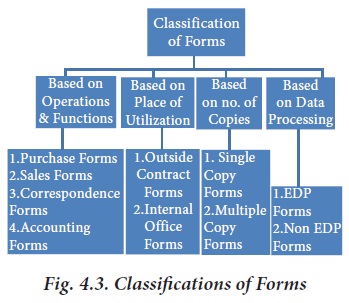
The forms can be broadly classified as under:
I. Based on the Office Function or Operation for Which They are Used, Viz.
1.
Purchase Forms: A purchase form is a commercial document and first official offer issued by a buyer to
a seller, indicating types, quantities, and agreed prices for products or
services. E.g., Purchase requisition form, Order form
2.
Sales Forms: A sales form is an
internal document of the company. It is generated by the
company itself for selling their goods.
3.
Correspondence Forms: Any written or digital communication exchanged by two or more parties.
Correspondences may come in the form of letters, emails, text messages,
voicemails, notes, or postcards.
4.
Accounting Forms: The account form balance sheet is a financial statement format where the assets are
reported on the left side and the liabilities are reported on the right side.
The account form is kind of a visual representation of the accounting equation.
II. Based on Place of Utilization:
1.
Outside Contract
Forms: Forms
sent to customers, creditors and other persons
(outside the office) with whom the firm does business from the office (e.g.,
cheques, orders, invoices, statements, vouchers, etc.)
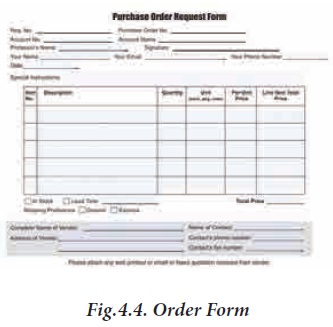
2.
Internal Office Forms:
Forms which are used by the employees of a business internally within the office
(e.g., memorandum forms, requisitions, accounting forms, report forms, etc.).
III. Based on the Number of Copies Required:
1. Single Copy Forms: Single copy form is used to serve the only one purpose and kept by any one of the
office employee. E.g. Employment application forms.
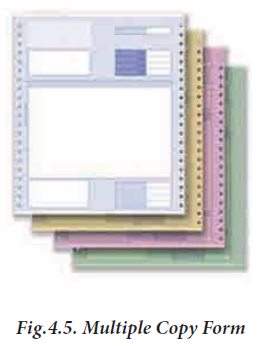
2. Multiple Copy
Forms: These
are prepared in duplicate or
triplicate-the copies being used to transmit information to other departments
or used as additional record ex. sub type unit, fan or Z arrangement.
IV. Based on Data Processing:
i.
EDP Forms: EDP Forms which are used on computers and other data processing
machines.
ii.
Non-EDP Forms: These forms are not used in EDP but are otherwise used on
typewriters or to write in hand etc.
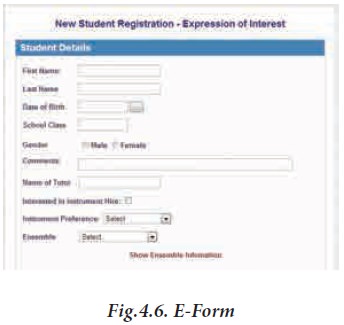
E-Form (Electronic Form):
An
e- form is a computer program version of a paper form. E-forms eliminate the
cost of printing, storing, and distributing pre-printed forms, and the wastage
of outdated forms. E-forms can be filled out faster because the programming
associated with e-forms can automatically- format, calculate, look up and
validate information for the user.
Benefits of E-Form:
·
It
is easier to fill when compare to paper form.
·
It
can be easily and quickly responded.
·
Adding
questions and editing information can be done quickly and easily.
·
Forms
are made secure through use of password protection.
·
It
saves time and money.
Need for Office Forms:
Modern
business depends much upon record. “A record is any written data that is made
for possible future use.” Forms are needed together and preserve information
for present and future use. Need for office forms arise as they serve the
following purposes:
a.
Gathering and
Communicating Information: They collect the needed data and then
communicate the same to perform different tasks.
b.
Providing Specific
Location: They provide a specific location for each item of information needed
and thus the work of data entry, processing and reference becomes easy.
c.
Elimination of
Recopying: As forms used to collect regular
and standard information are prepared in duplicate and triplicate they
eliminate the need for recopying repetitive or standard information, thus
saving much time and money.
d.
Identification of
Records: They
help to identify records and facilitate filing for
future reference.
Advantages of Office Forms:
·
It
simplifies office methods and procedures.
·
It
reduces cost of office operations by reducing the amount of manual or machine
writing and thereby increasing the output of each worker.
·
Office
forms are useful where it is desirable to fix responsibility for work done.
·
Business
information can be received or collected, recorded, processed and transmitted
in a systematic and efficient way with the help of office forms
Factors to be Considered in Forms Designing:
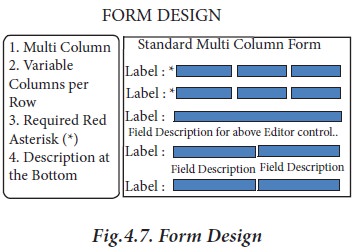
Following
are the factors to be considered while designing office forms:
1. Forms must be designed according
to the purpose of their use: The general purpose
of a form is to make clerical work easier than what it would be if a blank
paper was used.
2. Forms should be easy to use: The manner in which a form will be
used must be kept in view while designing the forms and choosing the quality of
paper for its printing. A form which is to be used on a typewriter or on a
book-keeping machine should be so designed that it may have minimum number of
starting places for the typist.
3. The design of forms should be
simple and facilitate the use: A simple design generally makes the form more convenient to
use. The design should enable the placing of matter to be easily done.
4. Each type of form should bear a
title and number:
To use a form, one must refer to it by a title or number. The title of the form
should be standardised and printed at the top. It should be clearly descriptive
but short. The form title is more easily remembered by the clerks than the
serial number.
5. The size of the form should be
decided in accordance with the purpose in view: There is no hard and fast rule
regarding the exact size of a form.
6. The type face for printing forms
should be clear and distinct for purposes of reading: The form designer has to keep in
view the type- face for printing so as to make the printed form neat and
compact.
7. The right type of
paper should be selected for every form: The printing, typing or writing impression desired will determine the quality of
paper suited for the purpose. The appearance of the forms as regards finish
colour, weight, etc., makes an appeal to the person to whom they are addressed.
8. Adequate provision should be made
for punching, scoring and perforating the forms: If forms are required to be punched for binders, it should be
arranged by specifying standard measurements from centre to centre of the
holes. Scoring means impressing a line on the form which crease the paper so
that time of printing. Perforation of certain forms may be required or a series
of short dash(--) marks which cut partially through the paper.
Related Topics